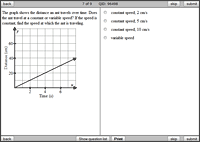6th Grade Math
Thinkwell's 6th Grade Math includes thousands of automatically graded 6th grade math problems, printable worksheets for each topic and subchapter, and lots of animated interactivities, but at the heart of it are fun and effective video lessons that students love to use.
Edward Burger is an award-winning teacher with a passion for teaching math, and he makes 6th grade math simple for all students. His video lessons easily teach math to students who struggle with old-fashioned textbooks in a typical classroom. It's the perfect study aid, and because it's available any time you need it for one fixed price, instead of by the hour, it's better than a math tutor.
Our complete 6th Grade Math package includes:- 12-month Online Subscription to our complete 6th Grade Math course with video lessons, automatically graded exercises, and much more.
- CD Set (optional) contains all of the video lessons so that you can watch them when you're away from the internet.
CD Sets require the purchase of an online subscription.
Money-Back Guarantee
6th Grade Math Materials
Online Subscription, 12-month access
Access to a complete online package that includes everything you need:
- High quality video lessons explain all of the 6th Grade Math concepts
- Automatically graded exercises with immediate feedback allow you to track your progress
- Subscriptions start when you are ready. Buy now and activate your course anytime you like. Wait up to one year to activate your subscription; your 12-month subscription doesn't begin until you say so!
CD Set Video Lectures on CD-ROM
This optional CD-ROM set delivers the exact same video lectures delivered online, but without an internet connection. Online Subscription is required; CDs not sold separately. The CDs only contain the videos.
6th Grade Math Details
Thinkwell's 6th Grade Math includes all of these features for your student:
- Aligned to Grade 6 National Math Standards
- More than 100 topics with 250+ video lessons
- 1000+ interactive exercises with immediate feedback allow you to track your progress
- More than 60 interactivities with audio
- Automatically graded 6th grade math tests, including 13 chapter tests, as well as practice tests, a midterm, and a final exam (only available in the homeschool version)
- Real-world application examples in both lectures and exercises
- Glossary of more than 200 mathematical terms
- Closed captioning for all video lessons (most are also available in Spanish)
- Brand-new content to help students advance their mathematical knowledge:
- operations with whole numbers, fractions, decimals, and positive and negative numbers (integers)
- bar graphs, histograms, and line graphs
- solving equations and inequalities
- rates, ratios, percent, and proportions
- lines, angles, and polygons
- transformations and symmetry
- customary and metric units
- perimeter and area of polygons
- circumference and area of circles
- volume and surface area of three-dimensional figures
- relating tables and graphs
- graphing functions and slope
- experimental and theoretical probability
Table of Contents
(Expand All - Close All)1. Whole Numbers and Patterns
- 1.1 Whole Numbers and Exponents
- 1.1.1 Comparing and Ordering Whole Numbers
- 1.1.2 Estimating with Whole Numbers
- 1.1.3 Exponents
- 1.2 Using Whole Numbers
- 1.2.1 Order of Operations
- 1.2.2 Properties and Reasoning Methods
- 1.2.3 Choose the Method of Computation
- 1.2.4 Patterns and Sequences
2. Introduction to Algebra
- 2.1 Variables and Expressions
- 2.1.1 Variables and Expressions
- 2.1.2 Translate Between Words and Math
- 2.1.3 Translating Between Tables and Expressions
- 2.2 Introduction to Equations
- 2.2.1 Equations and Their Solutions
- 2.2.2 Addition Equations
- 2.2.3 Subtraction Equations
- 2.2.4 Multiplication Equations
- 2.2.5 Division Equations
3. Decimals
- 3.1 Introduction to Decimals
- 3.1.1 Representing, Comparing, and Ordering Decimals
- 3.1.2 Rounding and Estimating Decimals
- 3.1.3 Adding and Subtracting Decimals
- 3.2 Multiplying and Dividing Decimals
- 3.2.1 Multiplying Decimals
- 3.2.2 Applying Exponents: Scientific Notation
- 3.2.3 Dividing Decimals by Whole Numbers
- 3.2.4 Dividing by Decimals
- 3.2.5 Solving Decimal Equations
4. Number Theory and Fractions
- 4.1 Number Theory
- 4.1.1 Divisibility
- 4.1.2 Factors and Prime Factorization
- 4.1.3 Greatest Common Factor
- 4.2 Representing Fractions
- 4.2.1 Decimals and Fractions
- 4.2.2 Equivalent Fractions
- 4.2.3 Mixed Numbers and Improper Fractions
- 4.3 Introduction to Operations with Fractions
- 4.3.1 Comparing and Ordering Fractions
- 4.3.2 Adding and Subtracting with Like Denominators
- 4.3.3 Estimating Fraction Sums and Differences
5. Operations with Fractions
- 5.1 Adding and Subtracting Fractions
- 5.1.1 Least Common Multiple
- 5.1.2 Adding and Subtracting with Unlike Denominators
- 5.1.3 Adding and Subtracting Mixed Numbers
- 5.1.4 Regrouping to Subtract Mixed Numbers
- 5.1.5 Solving Fraction Equations: Addition and Subtraction
- 5.2 Multiplying and Dividing Fractions
- 5.2.1 Multiplying Fractions by Whole Numbers
- 5.2.2 Multiplying Fractions
- 5.2.3 Multiplying Mixed Numbers
- 5.2.4 Dividing Fractions and Mixed Numbers
- 5.2.5 Solving Fraction Equations: Multiplication and Division
6. Data Displays
- 6.1 Organizing and Displaying Data
- 6.1.1 Measures of Central Tendency
- 6.1.2 Frequency Tables, Stem-and-Leaf Plots, and Line Plots
- 6.1.3 Bar Graphs and Histograms
- 6.2 Line Graphs and Assessing Displays
- 6.2.1 Line Graphs
- 6.2.2 Misleading Graphs
- 6.2.3 Choosing An Appropriate Display
7. Proportional Relationships
- 7.1 Ratios and Proportions
- 7.1.1 Ratios and Rates
- 7.1.2 Applying Rates and Ratios
- 7.1.3 Proportions
- 7.2 Applications of Proportions
- 7.2.1 Similar Figures
- 7.2.2 Indirect Measurement
- 7.2.3 Scale Drawings and Maps
- 7.3 Percent
- 7.3.1 Percents
- 7.3.2 Percents, Decimals, and Fractions
- 7.3.3 Percent Problems
- 7.3.4 Using Percents
8. Geometric Relationships
- 8.1 Lines and Angles
- 8.1.1 Points, Lines, and Planes
- 8.1.2 Measuring and Classifying Angles
- 8.1.3 Angle Relationships
- 8.1.4 Classifying Lines
- 8.2 Polygons
- 8.2.1 Triangles
- 8.2.2 Quadrilaterals
- 8.2.3 Polygons
- 8.3 Polygon Relationships
- 8.3.1 Geometric Patterns
- 8.3.2 Congruent Polygons
- 8.3.3 Transformations
- 8.3.4 Line Symmetry
9. Measurement
- 9.1 Customary and Metric Measurement
- 9.1.1 Understanding Customary Units of Measure
- 9.1.2 Understanding Metric Units of Measure
- 9.1.3 Converting Customary Units
- 9.1.4 Converting Metric Units
- 9.1.5 Time and Temperature
- 9.2 Measuring Geometric Figures
- 9.2.1 Finding Angle Measures in Polygons
- 9.2.2 Perimeter
- 9.2.3 Circles and Circumference
10. Area and Volume
- 10.1 Area
- 10.1.1 Area of Rectangles and Parallelograms
- 10.1.2 Area of Triangles and Trapezoids
- 10.1.3 Area of Composite Figures
- 10.1.4 Changing Dimensions
- 10.1.5 Area of Circles
- 10.2 Volume and Surface Area
- 10.2.1 Three-Dimensional Figures
- 10.2.2 Volume of Prisms
- 10.2.3 Volume of Cylinders
- 10.2.4 Surface Area
11. Integers and the Coordinate Plane
- 11.1 Introduction to Integers
- 11.1.1 Integers in Real-World Situations
- 11.1.2 Comparing and Ordering Integers
- 11.1.3 The Coordinate Plane
- 11.1.4 Transformations in the Coordinate Plane
- 11.2 Operations with Integers
- 11.2.1 Adding Integers
- 11.2.2 Subtracting Integers
- 11.2.3 Multiplying Integers
- 11.2.4 Dividing Integers
- 11.2.5 Solving Integer Equations
12. Functions, Equations, and Inequalities
- 12.1 Functions
- 12.1.1 Tables and Functions
- 12.1.2 Graphing Functions
- 12.1.3 Slope and Rate of Change
- 12.2 Solving Equations and Inequalities
- 12.2.1 Solving Two-Step Equations
- 12.2.2 Solving Inequalities
- 12.2.3 Solving Two-Step Inequalities
13. Probability
- 13.1 Understanding Probability
- 13.1.1 Introduction to Probability
- 13.1.2 Experimental Probability
- 13.1.3 Counting Methods and Sample Spaces
- 13.2 Finding Probabilities
- 13.2.1 Theoretical Probability
- 13.2.2 Compound Events
- 13.2.3 Making Predictions
About the Author

Video Lessons

Interactive Exercises


